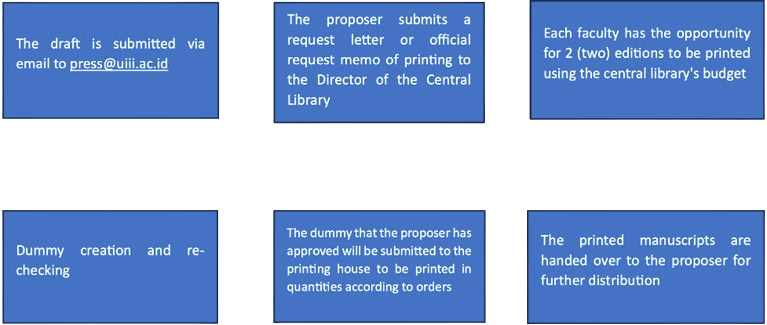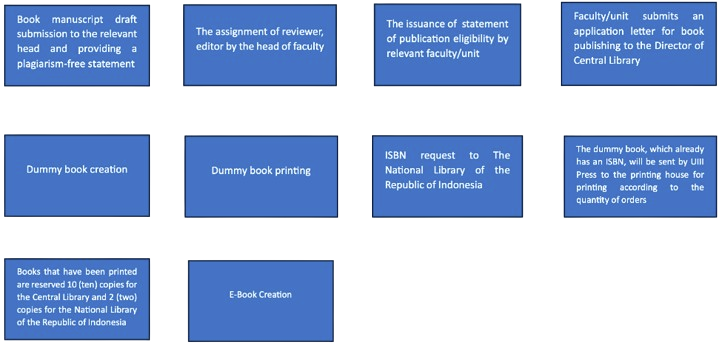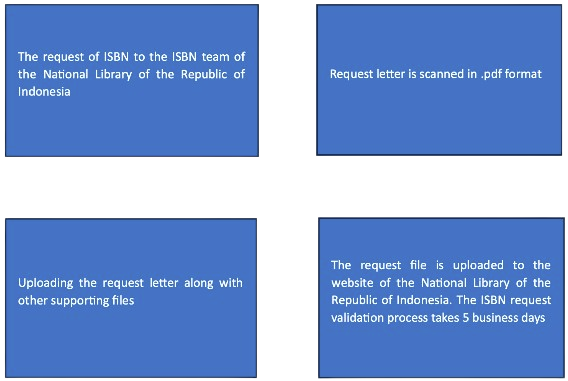Publication Guide
A detailed guide to meticulously preparing, submitting, and managing your manuscripts, books, and journals, ensuring a smooth journey from draft to publication.
Manuscript Writing Format at UIII Press:
- Manuscript is typed using Times New Roman font style.
- Font size is 12 pt.
- Spacing (leading) 2, without Add Space Before/After Paragraph.
- Left margin 3 cm, right 2 cm, top 3 cm, and bottom 2 cm.
- Page/file size A4.
- The submitted manuscript is complete manuscript, considering the elements as follows:
- Title;
- Foreword;
- Table of Content;
- List of Table (if any);
- List of figures;
- Discussion;
- Bibliography;
- Glossary;
- Index;
- Appendix;
- Narrative Biodata + Author’s photograph; and/or
- Synopsis (1 (one) page A4 for back cover).
- For reference books and Journal, a minimum number of submitted manuscript pages is 150 (one hundred fifty) pages, excluding the title page, foreword, table of contents, bibliography, and supporting page (glossary, indexes, appendices, etc). UIII Press reserves the right to directly reject manuscripts with a thickness of less than (one hundred) pages without previously going through the review process.
- Provision as the number 7 is exempted for popular scientific books. Specifically for popular scientific manuscripts, the thickness is 80-150 (eighty to one hundred and fifty) pages.
- The writing of tables does not use JPG/Excel format, but instead is typed using the “insert table” feature of MS. Word. Every table included in the manuscript must be cited with its source.
- The figures should use high resolution (minimum 300 pixels), original images, and preferably not taken from the internet.
- Charts are created manually (not in the form of photos) and accompanied by captions and sources.
- References, especially from websites/the internet, should include the complete source.
- The proposed title must be a fixed title. The title that has been registered with the National Library of the Republic of Indonesia cannot be changed for any reason.
- The author has the right to revise the manuscript 1x (once) after proofreading, but is not allowed to change many parts or completely change the entire manuscript.
To be publishable, a manuscript should be written with a complete structure. The manuscript structure is as follows:
- Title page
The title page consists of the full title of the manuscript with its subtitle, as well as the author's name. If the author is more than 1 (one) person, then all of them are written. - Author’s preface
The author must write the preface in a balanced way and represent the content of the book. - Foreword
In a book, especially a scientific one, the publisher's preface or expert reviewer's foreword is crucial. This is to prove that the manuscript is indeed worth reading. The manuscript should be accompanied by an introduction by an expert in the field that is the subject of the manuscript. - Table of contents
The table of contents includes every chapter title, subchapter, and sub-subchapter of the manuscript. Those that are written in the table of contents must match those that are in the manuscript. - List of tables
The numbering and caption of table titles must correspond to those in the manuscript. In the list of tables, it is not necessary to mention the source of the table. - List of figures
The numbering and captions of figures must correspond to those in the manuscript. It is not necessary to mention the source of the figures in the list of figures. - The content of the manuscript
The content section is written and formatted with chapters according to the topics studied. It is preferable that all chapters have a balanced composition so that no chapter has too many subchapters or pages, while others have too few subchapters and pages. - Bibliography
The bibliography lists all references used in the manuscript, formatted according to the topics studied. A balanced composition across chapters is preferable. - Appendices
It contains appendices that could be included in the manuscript. - Glossary
It contains explanations of important terms found within the manuscript. For academic books, it is highly recommended to include a glossary. - Index
It contains a list of important terms found within the manuscript. For academic books, it is highly recommended to include an index. - Author bio
The author bio is not an extensive curriculum vitae exceeding one page, but rather a brief narrative consisting of 2-3 paragraphs about the author(s) of the manuscript. If the manuscript is written by more than one person, biographies for all authors are included. - Synopsis
The synopsis contains a brief explanation of the book's contents. The maximum length of the synopsis is 1 (one) A4 page.
- The draft submitted to UIII Press is the one that is ready for printing.
- The draft is submitted via email to press@uiii.ac.id.
- The proposer submits a request letter or official request memo of printing to the Director of the Central Library.
- Each faculty has the opportunity for 2 (two) editions to be printed using the central library's budget.
- The printing house creates a dummy and submits it back to UIII Press for final review by the manuscript proposer.
- The dummy that the proposer has approved will be submitted to the printing house to be printed in quantities according to orders.
- The printed manuscripts are handed over to the proposer for further distribution.

- The author (lecturer/educational staff/student) prepares a request letter and submits the book manuscript, which is already in draft form, to the head of faculty/unit, accompanied by a plagiarism-free statement.
- The head of the faculty/unit assigns experts/specialists to serve as reviewers and/or editors.
- The faculty/unit issues a statement that the book is eligible for publication.
- The faculty/unit submits a request letter for book publishing to the Director of the Central Library, accompanied by a statement certifying that the book has been reviewed and a plagiarism-free statement from the author.
- The book manuscript will be given to UIII Press printing house to create a dummy book.
- The approved dummy book, which has been finalized and reviewed by the author, will be offered to a leading general publisher. Subsequently, the book will be published by the publisher and will then collaborate with UIII Press. The author will receive royalties from the publisher according to the applicable terms and conditions.
- If the manuscript is published by UIII Press, then UIII Press submits a request for an International Standard Book Number (ISBN) from the National Library of the Republic of Indonesia.
- The dummy book, which already has an ISBN, is sent by UIII Press to the printing house to be printed according to the quantity of orders.
- Books that have been printed are reserved 10 (ten) copies for the Central Library and 2 (two) copies for the National Library of the Republic of Indonesia.
- Books that have been printed are converted into e-books to be stored by the central library in the library system.


ISBN
Every book published by UIII Press will be given a serial number (ISBN). The ISBN number is issued by the National Library of the Republic of Indonesia. UIII Press submits an ISBN request online via the National Library of the Republic of Indonesia (Perpusnas RI) website. The process to obtain an ISBN number is as follows:
- The publisher submits a request letter for an ISBN to the ISBN team of the National Library of the Republic of Indonesia.
- The request letter is scanned in .pdf format.
- The request letter is uploaded along with other supporting files as attachments, namely the main title page, the full title page containing the title of the manuscript, author, and publisher name, copyright page, and table of contents of the manuscript.
- The file is uploaded to the website of the National Library of the Republic of Indonesia.
- The ISBN request validation process takes 5 business days. Once a title has been successfully validated, it cannot be changed for any reason.
